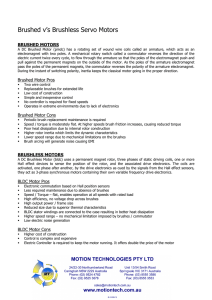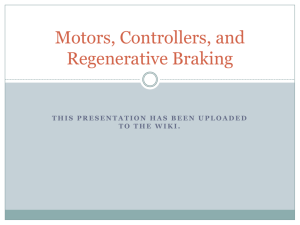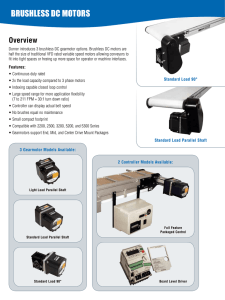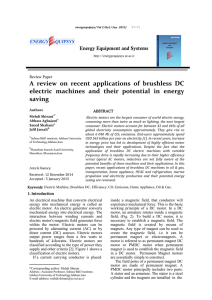Brush vs Brushless DC motors
advertisement
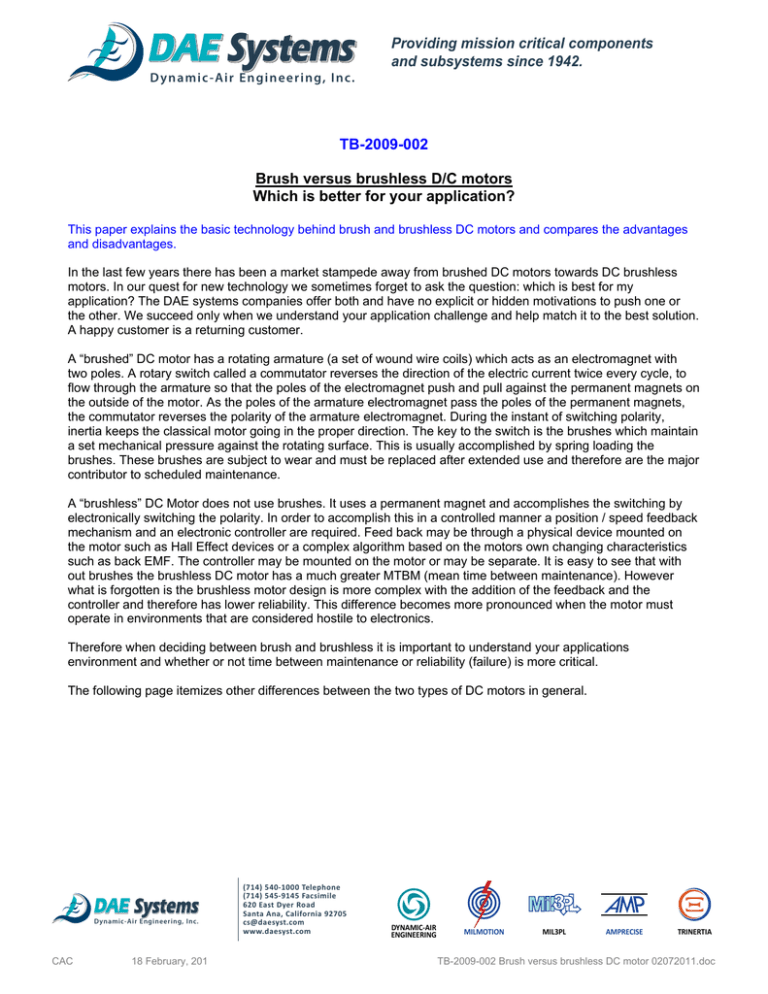
DAE Systems Providing mission critical components and subsystems since 1942. D y namic -Air Engineering, Inc. TB-2009-002 Brush versus brushless D/C motors Which is better for your application? This paper explains the basic technology behind brush and brushless DC motors and compares the advantages and disadvantages. In the last few years there has been a market stampede away from brushed DC motors towards DC brushless motors. In our quest for new technology we sometimes forget to ask the question: which is best for my application? The DAE systems companies offer both and have no explicit or hidden motivations to push one or the other. We succeed only when we understand your application challenge and help match it to the best solution. A happy customer is a returning customer. A “brushed” DC motor has a rotating armature (a set of wound wire coils) which acts as an electromagnet with two poles. A rotary switch called a commutator reverses the direction of the electric current twice every cycle, to flow through the armature so that the poles of the electromagnet push and pull against the permanent magnets on the outside of the motor. As the poles of the armature electromagnet pass the poles of the permanent magnets, the commutator reverses the polarity of the armature electromagnet. During the instant of switching polarity, inertia keeps the classical motor going in the proper direction. The key to the switch is the brushes which maintain a set mechanical pressure against the rotating surface. This is usually accomplished by spring loading the brushes. These brushes are subject to wear and must be replaced after extended use and therefore are the major contributor to scheduled maintenance. A “brushless” DC Motor does not use brushes. It uses a permanent magnet and accomplishes the switching by electronically switching the polarity. In order to accomplish this in a controlled manner a position / speed feedback mechanism and an electronic controller are required. Feed back may be through a physical device mounted on the motor such as Hall Effect devices or a complex algorithm based on the motors own changing characteristics such as back EMF. The controller may be mounted on the motor or may be separate. It is easy to see that with out brushes the brushless DC motor has a much greater MTBM (mean time between maintenance). However what is forgotten is the brushless motor design is more complex with the addition of the feedback and the controller and therefore has lower reliability. This difference becomes more pronounced when the motor must operate in environments that are considered hostile to electronics. Therefore when deciding between brush and brushless it is important to understand your applications environment and whether or not time between maintenance or reliability (failure) is more critical. The following page itemizes other differences between the two types of DC motors in general. Dynamic-Air Engineering, Inc. CAC 18 February, 201 (714) 540‐1000 Telephone (714) 545‐9145 Facsimile 620 East Dyer Road Santa Ana, California 92705 cs@daesyst.com www.daesyst.com DYNAMIC‐AIR ENGINEERING MILMOTION MIL3PL AMPRECISE TRINERTIA TB-2009-002 Brush versus brushless DC motor 02072011.doc DAE Systems Providing mission critical components and subsystems since 1942. D y namic -Air Engineering, Inc. Which is superior for more applications? Attribute Brush Type Cost Mean Time Between Maintenance Mean Time Between Failures Flat Speed / Torque Curve High efficiency High Output to frame size ratio Higher speed range Extreme Environments Simple installation Dynamic-Air Engineering, Inc. CAC 18 February, 201 (714) 540‐1000 Telephone (714) 545‐9145 Facsimile 620 East Dyer Road Santa Ana, California 92705 cs@daesyst.com www.daesyst.com Brushless DYNAMIC‐AIR ENGINEERING MILMOTION MIL3PL AMPRECISE TRINERTIA TB-2009-002 Brush versus brushless DC motor 02072011.doc
